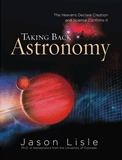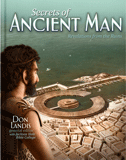News to Note, December 6, 2008
A weekly feature examining news from the biblical viewpoint
Sowing alien seed, the tools to shake up evolution, the power of design, and more!
1. Seeds of Life Found on most Planets Upon Formation
Are the seeds of life commonly planted when a planet is formed?
2. Modern Human Sophistication: How Long Did It Take?
Yesterday’s humans weren’t as sophisticated as today’s humans—according to today’s humans.
3. A Sea of Change for Turtle Origin Theories
Turtle evolution is yet again in the news—and, yet again, the evolution is only in evolutionists’ minds.
4. A Reminder That DNA Mutations Are More Counterproductive Than Helpful Thing”
From mid-November, a reminder that mutations are nearly always counterproductive.
5. Debating the Origin of Sex
At the beginning He made them male and female—emphasis on the “and”?
6. BBC News: “Mystery of Dolphins’ Speed Solved”
A new study has determined how dolphins swim so fast: really, really powerful tails.
The mystery of dolphins’ amazing speed is so confounding that it is even described by a paradox. Gray’s Paradox, named after zoologist Sir James Gray, was rooted in his 1936 observations of dolphins swimming at more than 20 miles (32 km) an hour, a press release notes. Yet he concluded dolphins’ muscles couldn’t be powerful enough to support such speeds.
Researchers at the Rensselaer Polytechnic Institute have finally solved the “paradox” by studying the movement of water around dolphins while they swim. The study involved a technique called “digital particle image velocimetry” that required the dolphins to swim through tanks with millions of tiny bubbles, the speed and direction of which were then measured.
While Gray concluded that the secret to dolphin speed lay in their anti-drag skin, the researchers discovered he had underestimated the actual strength of the dolphin’s tail. In the team’s tests, the dolphins exerted an average of 200 lbs (91 kg) of force while swimming, maxing out at 400 lbs (181 kg) of force while “walking” upright mostly above the water, as seen in dolphin shows. (Human swimmers exert about 60 to 70 lbs (27–36 kg) of force at most.)
So it seems this is yet another example of God’s design in dolphins, which are also well-known for their keen intelligence.
For more information:
- Get Answers: Design Features
7. Engineers Take Cues From Fish In New Energy Turbine Design
Energy-generating turbines could take a cue from fish, according to a new study.
Traditional turbines are most effective in powerful currents, but researchers are trying to change that so that slower currents can produce power. Today, smaller-current turbines use principles of lift to become “underwater windmills” and maximize their production. But a team led by Michael Bernitsas at the University of Michigan is looking at underwater creatures for inspiration.
8. BBC News: “Rare Bronze Age Necklace is Found”
An amber necklace that could be 4,000 years old has been dug up near Manchester.
Archaeologists discovered the necklace while excavating a type of stone-lined grave known as a cist, and have dated the find to around 2,000 BC.
While we may not be as confident about the exact date, the find is a reminder that, like us, our human ancestors appreciated art and wore jewelry. In fact, the style of this necklace wouldn’t seem out of place in certain circles today.
Also of interest is that the nearest source of amber from the time may have been the Baltics, reminding us of ancient trade and travel and the “modernity” of humans since creation.
For more information:
- Does Archaeology Support the Bible?
- Get Answers: Anthropology
9. The Telegraph: “£35,000 of Taxpayers’ Cash Given to ‘Atheist Bus’ Group”
British taxpayer dollars are benefiting lectures on atheism—all part of a government program to fund “debates about the place of religion in public life.”
Britain’s Telegraph reported that the pro-secularism British Humanist Association—which, as we noted in October, has funded an atheistic bus campaign in London (soon mimicked in the United States)—has received more than $50,000 in government money for a series of conferences on “whether it is right for the devout to be given special treatment in the workplace.” (The story curiously disappeared from the Telegraph’s website a few days later. The Welsh Western Mail has a similar report.)
One honestly wonders if much headway will be made in the debates (one passed, three to come over the next three months), other than a government-funded regurgitation of the same old views. Also, although termed debates, the news reports only on the humanist speakers. For example, one of the conferences will be keynoted by philosopher A. C. Grayling, who has claimed, “Religious belief shares the same intellectual respectability and rationality as belief in the existence of fairies.” Another will be led by a legislator whose views on abortion have earned him the moniker “Dr. Death.” While BHA chief executive Hanne Stinson claims “Speakers are being asked to explore the issues, not to push a line,” we imagine their talking points will be more than a little predictable.
As for us, it’s hard to disagree with one critic’s comparison of the situation to paying the Taliban to lecture on women’s rights.
For more information:
- Is There Really a God?
- Get Answers: God, Religion
10. Local Museum Partnership Ends
The Creation Museum is once again the center of an evolutionist-hatched controversy concerning local area tourism promotions.
Remember, if you see a news story that might merit some attention, let us know about it! And thanks to all of our readers who have submitted great news tips to us. If you didn’t catch last week’s News to Note, why not take a look at it now? See you next week!
[Please note that links will take you directly to the source. AiG is not responsible for content on the websites to which we refer. For more information, please see our Privacy Policy.]
Recommended Resources

Answers in Genesis is an apologetics ministry, dedicated to helping Christians defend their faith and proclaim the good news of Jesus Christ.
- Customer Service 800.778.3390
- © 2024 Answers in Genesis



